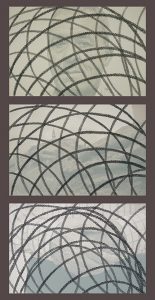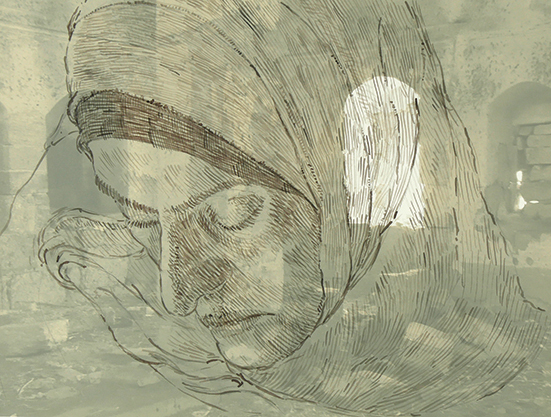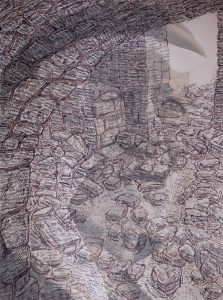Artworks by: John Halaka
Reviewed by: Faten Nastas Mitwasi
………………

This exhibition presents very delicate and mysterious artworks. Thousands of brush strokes and rubber-stamped words are carefully superimposed on digital photographs that are printed lightly to appear faded and ghostly. At close-up observation of the details, John Halaka’s brush strokes seem to present an abstract drawing, and with careful scrutiny the viewer begins to recognize words that have been repeatedly stamped on the drawing, as if they were conceptual works of art. Only from a distance does one discover the landscape scenes and portraits. The combination of people’s faces with images of destroyed villages results in an ever-shifting relationship that reflects both the presence and absence of the figures and the landscape.
On a profound level, “Ghosts of Presence – Bodies of Absence” represents “the highest form of art” which, as explained by Nietzsche in The Birth of Tragedy, results from the mixture of both Apollonian and Dionysian elements into one seamless whole. Halaka allows the viewer to apply and experience both reason and emotion, logic and ecstasy – the full spectrum of the human condition on technical and conceptual levels. Each of his works suggests a balance between abstraction and realism, documentation and conceptualism, beauty and brutality, nostalgia and pain – and invokes the presence and absence of the very figures and landscapes that he presents. Halaka draws the beautiful landscape of Palestinian villages with architectural elements, cactus plants, and other typical features in a unique style that lies somewhere between expressionism and pointillism to reach nostalgic realism. Yet the scenes are not complete, the beauty is not real: Halaka adds to the landscape a layer of words, superimposed by rubber stamps, to bring it to the reality of the present time. These words remind us of the brutality that the Palestinian people have experienced and recall the pain that they have lived through: remember, resist, survival, sacrifice, return, memorial, memory, survivors, desire, genocide, forgotten, freedom.

Whether they are survivors, those who were sacrificed (martyred), or those who belonged to the dead, the souls of the displaced are evoked through Halaka’s drawings and remain as dwellers in their native landscape. Sixty-nine years ago, the stones and architectural ruins were flourishing homes that sheltered generations of expanding families. The lands in these drawings belonged to the people whom Halaka commemorates, presenting them as immortal ghosts who are part of and witness to the history of a usurped nation.

Through basic techniques (drawing, stamping, and photography), Halaka recalls layers and decades of history. With modest materials (ink and digital photographs on drawing paper), he evokes deep memories. Through his artworks, Halaka echoes John Berger: “As long as there are people who tell [their] story, the same story, their nation will continue to survive.” The art of John Halaka is based on the story of the Palestinian nation. Yet with the brutality that is continuously being imposed on various nations, especially in the Levant, Halaka’s artwork investigates the crisis of exiled people anywhere in the world and powerfully reflects their tragedy.
Art functions as an international, common language by which artists communicate with their audiences and provoke them to think, feel, and contemplate. Halaka, through these breathtaking artworks, communicates his universal vision of justice and recommends a set of guidelines to all uprooted people: To realize Freedom one should resist, sacrifice, remember, survive, return, and never forget.

